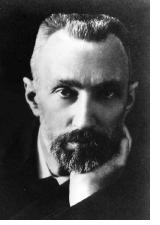Pierre Curie
physical chemist, b. 15 May 1859 (Paris, France), d. 19 April 1906 (Paris)
 The young Pierre curie received his education from his father, a doctor. He developed a passionate interest in mathematics, particularly three-dimensional geometry. He matriculated at the age of 16, obtained his licence in sciences at the age of 18, and became a laboratory assistant at the Sorbonne (the University of Paris) in 1878.
The young Pierre curie received his education from his father, a doctor. He developed a passionate interest in mathematics, particularly three-dimensional geometry. He matriculated at the age of 16, obtained his licence in sciences at the age of 18, and became a laboratory assistant at the Sorbonne (the University of Paris) in 1878.
At the University Pierre's mathematical inclination led him to study infrared electromagnetic waves (heat waves) and calculate their wavelengths. He then turned to the study of crystals. Together with his brother Jacques he discovered piezoelectricity (the generation of electricity through a deformation of the crystalline structure). Pierre extended the study into a detailed description of the laws of symmetry.
After his appointment as supervisor at the School of Physics and Industrial Chemistry at Paris in 1882 Curie worked on improvements of the analytical balance. In the course of studies on magnetism he developed a torsion balance with a resolution of 0.01 mg, an instrument still in use and known as the magnetic balance of Curie and Chèneveau. He discovered that the magnetic coefficients of attraction of paramagnetic bodies vary in inverse proportion to the absolute temperature, a relationship known as Curie's Law.
In 1895 Curie obtained his doctorate of science with a thesis on magnetism and married Marie Sklodowska. The marriage developed into a most successful collaboration between two great scientists, beginning with the discovery of polonium and radium in 1898 and extensive studies of radioactivity, discovered by Henri Becquerel in 1896. Studying the physical properties of the new radiations, Pierre proved the existence of electrically positive, negative, and neutral particles in the radioactive emissions (that were later called alpha, beta, and gamma rays). By observing and documenting the physiological effects of radium he laid the foundations for radium therapy.
The University of Geneva offered Pierre Curie a professorial appointment, but he declined the offer, preferring instead to continue his work with Marie. In 1900 he was appointed lecturer at the Sorbonne and professor in 1904. In the following year he became a member of the Academy of Sciences. In 1903 he had already received the Nobel Prize for Physics, jointly with Marie and Becquerel.
Curie died in 1906 as a result of a fatal traffic accident in the rue Dauphine in Paris, where he was run over by a dray. His complete works were published in 1908.
home
 The young Pierre curie received his education from his father, a doctor. He developed a passionate interest in mathematics, particularly three-dimensional geometry. He matriculated at the age of 16, obtained his licence in sciences at the age of 18, and became a laboratory assistant at the Sorbonne (the University of Paris) in 1878.
The young Pierre curie received his education from his father, a doctor. He developed a passionate interest in mathematics, particularly three-dimensional geometry. He matriculated at the age of 16, obtained his licence in sciences at the age of 18, and became a laboratory assistant at the Sorbonne (the University of Paris) in 1878.